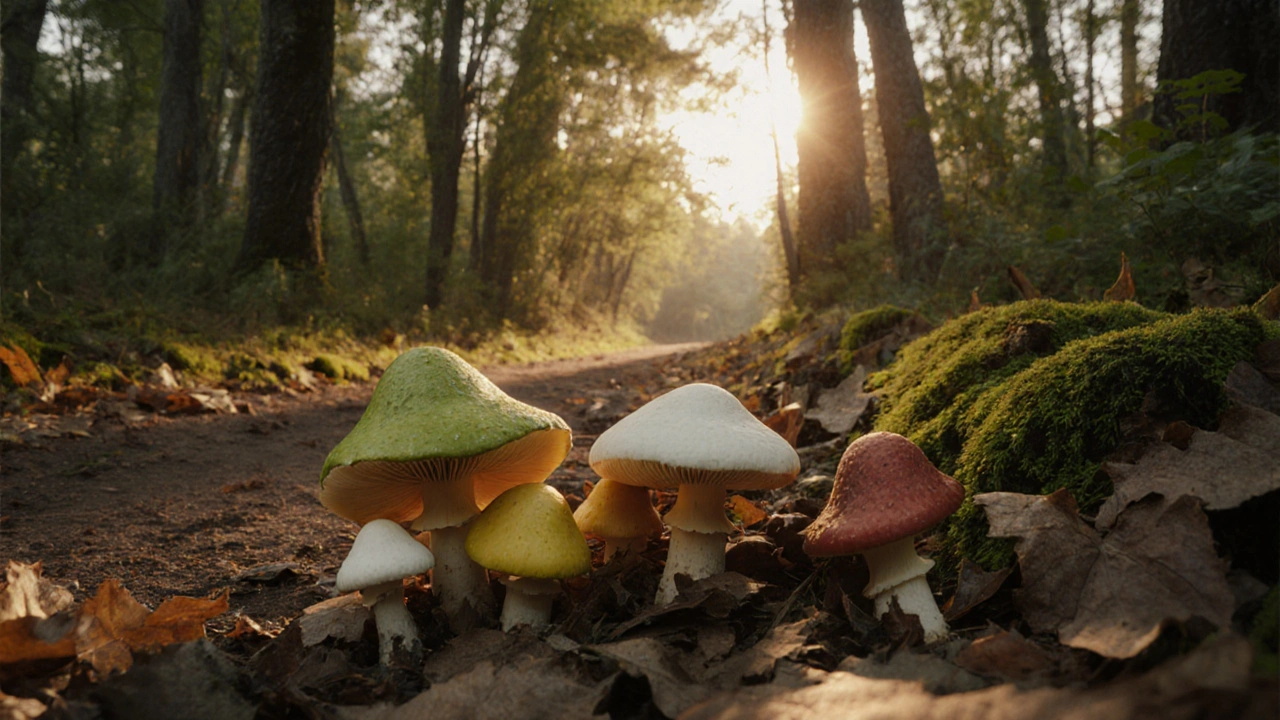Deadly Mushroom Identification Quiz
Test your knowledge of the top 5 deadliest mushrooms. Select the correct answer for each question.
Imagine you’re out for a walk in the woods, and a cluster of weird‑looking caps catches your eye. It’s tempting to snap a photo or even pick one, but some mushrooms hide lethality behind an innocent façade. Knowing the most poisonous mushrooms can mean the difference between a safe stroll and a medical emergency. Below we break down the five fungi that top the danger list, explain why they’re so toxic, and give you practical tips to avoid a close call.
Key Takeaways
- Death‑cap (Amanita phalloides) and Destroying Angel (Amanita virosa) cause irreversible liver damage.
- Galerina marginata looks like edible honey‑ mushrooms but carries amatoxins.
- Cortinarius rubellus contains orellanine, leading to delayed kidney failure.
- Gyromitra esculenta’s gyromitrin toxin can cause severe stomach cramps and seizures.
- Never rely on myths; always verify a mushroom with a trusted field guide or expert.
Amanita phalloides - The Death‑Cap
The death‑cap is the poster child for deadly fungi. With a greenish‑yellow cap, white gills, and a volva at the stem base, it often masquerades as edible puffballs or edible Amanita species. The culprit is amatoxin, a group of cyclic peptides that block RNA polymerase II, halting protein synthesis in liver cells. Even a half‑gram of fresh caps can be lethal for an adult.
Symptoms usually appear 6-12hours after ingestion and start with nausea, vomiting, and diarrhea. After a brief seeming recovery, severe liver failure sets in, often requiring liver transplantation. In regions like Europe, North America, and parts of Australia, the death‑cap thrives under oak, chestnut, and pine trees.
Amanita virosa - Destroying Angel
Destroying Angel looks pristine: pure white cap, white gills, and a smooth white stem. Its immaculate look deceives hikers into thinking it’s a harmless “white button.” Like the death‑cap, it contains amatoxins, making its toxicity identical. The lethal dose is similarly low‑risk‑free: roughly 0.1mg per kilogram of body weight.
After consumption, the first wave of gastrointestinal distress mirrors that of death‑cap, but the timeline can stretch to 24hours before liver symptoms surface. It grows in coniferous forests across Europe, North America, and parts of East Asia. Spotting the distinctive volva at the base can save you - it’s often buried in leaf litter.
Galerina marginata - Deadly Galerina
Deadly Galerina is a small brown mushroom that frequently nests on decaying wood. Its orange‑brown cap and fine, crowded gills make it easy to mistake for the beloved honey‑mushroom (Armillaria). Unfortunately, it also packs amatoxin, delivering the same liver‑killing action as Amanita species.
The mushroom’s size can mislead novices; a single cap may carry enough toxin to kill an adult. The symptoms follow the classic three‑phase pattern: early vomiting, a silent period, then acute liver failure. It’s common in temperate forests of North America, Europe, and parts of Australasia.
Cortinarius rubellus - Deadly Webcap
Cortinarius rubellus, also called the deadly webcap, wears a reddish‑brown cap and a faint, cobweb‑like veil (the “cortina”) that can be seen as a fine thread on the stem. Its toxin is orellanine, which targets kidney cells, causing irreversible renal failure.
One of the trickiest aspects of orellanine poisoning is the delayed onset - symptoms often surface 2-3days after ingestion, beginning with weak urine output, flank pain, and nausea. By the time kidney damage is evident, dialysis may be required. This mushroom is found in beech and conifer forests across Europe and North America, usually appearing late in the summer.
Gyromitra esculenta - False Morel
Gyromitra esculenta looks like a delicious morel, with its brain‑shaped, reddish‑brown lobes. However, when raw or insufficiently cooked, it releases gyromitrin, a volatile compound that hydrolyzes into monomethylhydrazine, a known neurotoxin.
Poisoning symptoms appear quickly: severe stomach cramps, vomiting, dizziness, and, in extreme cases, seizures or liver damage. Traditional processing-drying, then boiling three times-reduces toxin levels, but the risk remains high. Gyromitra grows in sandy soils under conifers in Europe and parts of North America.
Quick Comparison of the Top 5 Deadly Fungi
| Species | Common Name | Primary Toxin | Lethal Dose (mg/kg) | Typical Symptoms | Geographic Range |
|---|---|---|---|---|---|
| Amanita phalloides | Death‑Cap | Amatoxin | ~0.1-0.2 | GI upset → liver failure | Europe, N. America, Australia |
| Amanita virosa | Destroying Angel | Amatoxin | ~0.1 | GI upset → liver failure | Europe, N. America, East Asia |
| Galerina marginata | Deadly Galerina | Amatoxin | ~0.1 | GI upset → liver failure | Temperate forests worldwide |
| Cortinarius rubellus | Deadly Webcap | Orellanine | ~10-20 | Delayed kidney failure | Europe, N. America |
| Gyromitra esculenta | False Morel | Gyromitrin | Variable (raw) | GI distress, seizures, liver damage | Europe, N. America |
How to Spot and Avoid These Killers
When you’re out collecting fungi, follow these simple habits:
- Never rely on a single feature. Look at cap color, gill attachment, stem base, and habitat.
- Carry a reputable field guide or download an offline app with clear photos.
- Check for the volva (cup‑like structure) at the stem base - a red flag for Amanita species.
- Avoid any mushroom that’s growing on wood unless you’re 100% sure it’s edible.
- If a mushroom smells foul, has a bitter taste, or feels slimy, put it down.
- When in doubt, leave it. Consulting local mushroom clubs adds an extra safety net.
Treatment Options If You Suspect Poisoning
Time is critical. If you or someone else has eaten a suspect mushroom, do the following:
- Call emergency services immediately - mention “possible mushroom poisoning.”
- Do not induce vomiting unless instructed by a medical professional.
- If the victim is conscious, give activated charcoal (1g per kg) to bind toxins.
- Hospitals may administer high‑dose penicillin G, silibinin (from milk thistle), or N‑acetylcysteine for amatoxin cases.
- For orellanine poisoning, dialysis is often the only lifesaving measure.
- Supportive care - IV fluids, monitoring of liver enzymes, and renal function - is essential for all cases.
Next Steps for Foragers and Outdoor Enthusiasts
Even seasoned mushroom hunters can slip up. Here’s a quick checklist you can print and keep in your backpack:
- Take photos of both top and bottom of every find.
- Mark the exact location (GPS or landmarks).
- Note the tree species or substrate it grew on.
- Carry a small spool of paper for field notes.
- Review your findings with an expert before consumption.
Remember, most wild mushrooms are harmless, but a few are lethal. Knowledge, caution, and a healthy respect for nature keep your foraging adventures safe and enjoyable.
Frequently Asked Questions
Can cooking destroy amatoxin?
No. Amatoxin is heat‑stable, so boiling, frying, or baking does not reduce its toxicity. The only safe approach is to avoid ingestion entirely.
Why does orellanine poisoning take days to show symptoms?
Orellanine interferes with kidney cell metabolism, a process that unfolds slowly. The toxin accumulates, and clinical signs such as reduced urine output and flank pain often appear 48‑72hours after ingestion.
Is there an antidote for gyromitrin poisoning?
Supportive care is the mainstay. In severe cases, patients may receive intravenous benzodiazepines for seizures and liver function monitoring. There is no specific antidote.
How reliable are smartphone apps for mushroom identification?
Apps can be a helpful first step, but they’re prone to misidentification, especially with look‑alikes. Always cross‑check with a field guide or expert before consuming any mushroom.
What should I do if I suspect I’ve eaten a poisonous mushroom but feel fine?
Don’t wait for symptoms. Contact poison control or emergency services immediately and provide details about the mushroom’s appearance, location, and time of consumption. Early medical intervention improves outcomes.


Elle Trent
The article drowns in taxonomic jargon, skipping the practical field cues that a forager actually needs; a pocket guide beats a dissertation any day.
Jessica Gentle
First off, great job laying out the five deadly species in a clear, searchable format.
When you’re out in the woods, the most important habit is to always double‑check the volva at the stem base before you even think about picking a mushroom.
Both Amanita phalloides and Amanita virosa sport a distinctive cup‑like structure that can be hidden under leaf litter, so a quick sweep with a small trowel can save a life.
If you see a brown cap growing on decaying wood, pause – that’s the classic environment for Galerina marginata.
Even though Galerina looks like a harmless honey mushroom, its amatoxin content is identical to that of the death‑cap.
Orellanine, the toxin in Cortinarius rubellus, is a silent killer because symptoms don’t appear until two or three days later.
Because of that delayed onset, many people think they’re fine and only seek medical help when kidney failure is already underway.
Gyromitra esculenta’s gyromitrin turns into monomethylhydrazine when it’s cooked, which is why the mushroom must be boiled three times and the water discarded.
Unfortunately, even thorough preparation doesn’t eliminate all risk, so many mycologists advise avoiding false morels altogether.
A quick field‑note checklist can be printed on waterproof paper and tucked into your backpack.
Write down the cap color, gill attachment, stem features, and the tree species you’re under.
Take a photo of both the top and the underside; a side‑by‑side comparison later can reveal subtle differences you missed in the moment.
If you’re ever in doubt, resist the urge to taste – that’s a myth that has cost lives.
Instead, show your find to a local mushroom club or post a clear picture on a reputable identification forum.
Remember, most wild fungi are harmless, but the few that are lethal are often the ones that look the most appealing.
Staying educated and cautious turns a fun foraging trip into a safe adventure.
Samson Tobias
I've been out there chasing mushrooms for years, and I can’t stress enough how a calm, methodical approach saves lives.
Take a deep breath, note every detail, and if anything feels off, step back – the forest will still be there tomorrow.
Alan Larkin
While the guide is solid, you might want to flag the importance of spore print color – it’s a quick, reliable metric that even novices can master. 😊
Also, a reminder that the “white button” look of Amanita virosa can be mimicked by edible blusher mushrooms, so a thorough inspection of the ring and volva is non‑negotiable.
John Chapman
One might argue that emphasizing spore prints is a bit pedantic when the volva alone suffices for identification; after all, seasoned mycologists rarely rely on such elementary traits.